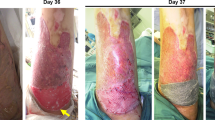Abstract
The use of Integra as an artificial dermal regeneration template is well established. Following initial use of Integra to resurface the wound bed, the second stage involves removal of the silicone layer and application of a split skin autograft. Previous histological studies have shown that neo-vascularisation of the Integra occurs between 2 and 4 weeks, and therefore, skin grafting over the Integra is recommended at any time after this period. We present a case of an infant with 38% total percentage of body surface area in whom we performed early burn excision and immediate application of Integra. In this case, the second stage of skin grafting was delayed, resulting in the formation of a crusty white membrane over the Integra. Histological analysis with a Von Kossa stain revealed evidence of calcification within the superficial layers of the Integra. Each leg was initially treated differently. In one leg, mechanical scrubbing of this layer was performed. The subsequent results of grafting in this leg were unsatisfactory, and repeat grafting was necessary. In the other leg, tangential excision using a Watson knife was performed before grafting. This produced much better results in terms of skin graft ‘take’. The causes of calcification in biomaterials are discussed, and recommendations are made on the basis of the clinical findings in this particular case.





Similar content being viewed by others
References
Heimbach D, Luterman A, Burke JF (1988) Artificial dermis for major burns: a multi-centre randomized clinical trial. Ann Surg 208:313 doi:10.1097/00000658-198809000-00008
Moiemen NS, Staino JJ, Ojeh NO, Thway Y, Frame JD (2001) Reconstructive surgery with a dermal regeneration template: clinical and histological study. Plast Reconstr Surg 108:93 doi:10.1097/00006534-200107000-00015
Nimni ME, Bernick DT, Cheung DE, Ertl D, Nishimoto WJ, Paule WJ et al (1988) Biochemical differences between dystrophic calcification of cross linked collagen implants and mineralisation during bone induction. Calcif Tissue Int 42:213 doi:10.1007/BF02556366
Nimni ME, Myers D, Ertl D, Han B (1997) Factors which affect the calcification of tissue-derived bioprostheses. J Biomed Mater Res 35:531 doi:10.1002/(SICI)1097-4636(19970615)35:4<531::AID-JBM13>3.0.CO;2-E
Stern R, Mcpherson M, Pharm D, Longaker MT (1990) Histological study of artificial skin used in the treatment of full thickness thermal injury. J Burn Care Rehabil 11:7 doi:10.1097/00004630-199001000-00003
Author information
Authors and Affiliations
Corresponding author
Rights and permissions
About this article
Cite this article
Ghattaura, A.S., Potokar, T.S. Calcified Integra membrane: one possible cause of skin graft failure in the second stage of Integra use. Eur J Plast Surg 32, 47–50 (2009). https://doi.org/10.1007/s00238-008-0278-3
Received:
Accepted:
Published:
Issue Date:
DOI: https://doi.org/10.1007/s00238-008-0278-3




